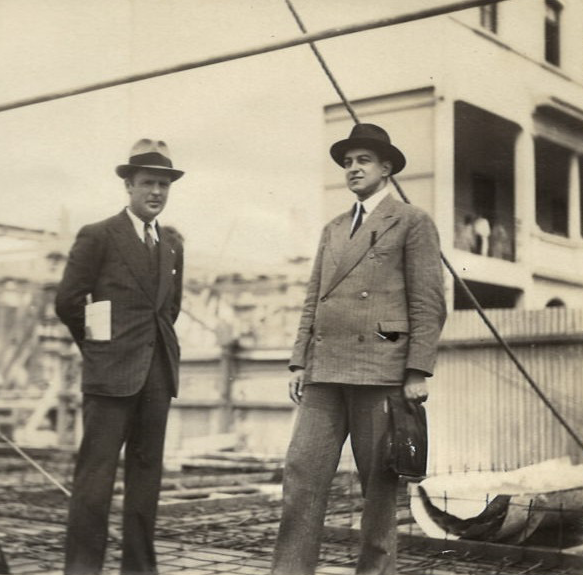Architecture, catholicism and rurality in Uruguay
Horacio Terra Arocena's career
DOI:
https://doi.org/10.18861/ania.2024.14.2.3861Keywords:
Biography, catholic social space, catholic humanism, legislation, agrarianism, rurality, villages, orchards, social housing, suburbAbstract
This text presents the uruguayan architect Horacio Terra Arocena (Montevideo, 1894-1985) through the key areas of action that defined his career. He was a renowned professional who presided over the Society of Architects and the Instituto Nacional de Viviendas Económicas. He participated in the Pan American Congresses of Architects and was a teacher at the Faculty of Architecture. He wrote essays on art theory and aesthetics and also a science fiction novel. He was a politician, parliamentarian representing the Civic Union and author of various laws.
As an agent of the catholic social space, he directed the newspaper El Bien Público, took charge of the magazine Tribuna Católica, and was the architectural advisor to the Curia of Montevideo, advising Monsignor Antonio María Barbieri. The neo-thomism of Jacques Maritain and the interpretation of time by the jesuit Teilhard de Chardin had a significant influence on his thinking, within the context of a renewed catholic interest in the spiritualism of Henry Bergson.
This article describes and analyzes the activity that Terra Arocena developed as a catholic architect. The argument is based on a methodology that refers to a qualitative study of various written sources. It is based on a detailed study of catholicism, from which emerges a persistent appreciation of rurality that rose up against the city and coincided with a current of architectural thought that discussed the values of large cities. In this context, the public function allowed him to carry out concrete actions to make the installation of an agrarian culture a reality in Uruguay, trusting that the farming solution could solve housing problems, both in the countryside and in the cities suburbs.
Downloads
References
Ardao, A. (1956). La filosofía en el Uruguay del siglo XX. México: Tierra Firme
Barrales, D.; Iglesias, N. (2021). ¿De qué lado está Cristo? Religión y política en el Uruguay de la Guerra Fría. Montevideo: Fin de Siglo
Bourdier, P. (2006). Génesis y estructura del campo religioso. Relaciones. Estudios de historia y sociedad, no. 108, pp. 29-83
Chiarino, J.V.; Saralegui, M. (1944), Detrás de la ciudad. Ensayo de síntesis de los olvidados problemas campesinos, Montevideo: impresora uruguaya.
Geymonat, R. (2021). Iglesia, Estado y sociedad en el Uruguay contemporáneo, 1960-2010. Montevideo: Ediciones de la Banda Oriental
Instituto de Teoría de la Arquitectura y el Urbanismo ITU (1957). La Ley de Formación de Centros Poblados. Montevideo: Facultad de Arquitectura.
Instituto de Teoría de la Arquitectura y el Urbanismo ITU (1958 ). Ley de Centros Poblados. Boletín informativo no. 14, Montevideo: Facultad de Arquitectura.
Méndez, M. (2016). Divinas Piedras. Catolicismo y arquitectura en Uruguay. Montevideo: Universidad de la República, Ediciones Universitarias.
Méndez, M.; Medero, S.; Cajade, M.; Canén, P.(2024). Casas Comunes. Arquitectura para la vivienda social en Uruguay. Montevideo; FADU, Udelar.
Nudelman, J. (2015). Tres visitantes en París. Los colaboradores uruguayos de Le Corbusier. Montevideo: Biblioteca Plural, Csic, Udelar.
Stone, L. (1971). Prosopography, Daedalus, Vol. 100, no. 1, pp. 46-79.
Tafuri, M. (1973). Storia dell'ideologia antiurbana, Venecia: IUAV
Terra Arocena, H. (1943). Proyecto sobre el mejoramiento de ejidos y la regulación urbanística de ciudades del interior. Revista del Instituto de Urbanismo, no 8, pp.105-117.
Terra Arocena, H. (1945). El programa y el carácter de un templo católico. Arquitectura, no. 214, pp.42-44.
Terra Arocena, H. (1945). Iglesia Votiva de Carrasco. Arquitectura, no.214, pp.46-47.
Terra Arocena, H. (1968). Integración en el tiempo, Montevideo: Barreiro y Ramos.
Terra Arocena, H. (1976). El planeta arreit. Un avanzado mundo nos juzga y nos emplaza. Montevideo: Barreiro y Ramos.
Terra Arocena, H. (1983). Terra Arocena, reconquistar garantías para los derechos de las personas, Aquí, Año 1, no.21, 6 de junio.
Zubillaga, C. (2020). Una historia silenciada. El catolicismo uruguayo ante la Guerra Civil Española y el franquismo (1936-1955). Montevideo: Cruz del Sur

Published
How to Cite
Issue
Section
License
Copyright (c) 2024 Mary Mendez

This work is licensed under a Creative Commons Attribution 4.0 International License.
The journal and its contents are licensed under the Creative Commons - Attribution 4.0 International License (CC BY 4.0). It is possible to copy, communicate and publicly distribute its content as long as the individual authors and the name of this publication are cited, as well as the publishing institution (Universidad ORT Uruguay).

